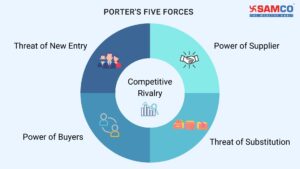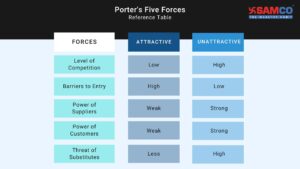Porter’s Five Forces are:
- Competition in the industry
- New entrants threat
- Power of suppliers
- Power of customers
- Threat of substitute products

A Brief History:
The Five Forces model is named after Michael E. Porter, a Harvard professor. It was first published in his book Competitive Strategy in 1980. He is a recipient of the Wells Prize in Economics, three McKinsey Awards, and is the author of 14 books. Porter shows how competitive advantage can be connected to profitability. He presents a new perspective on the company's quality analysis. Porter's framework is still relevant for predicting competitor behavior even after forty years of publication. It is broadly used to analyse the industry structure and its corporate strategy. These five forces are frequently used to measure the competition strength, attractiveness, and profitability. Let's learn how we can use these forces in our research process: 1. Competition in the industry Competition keeps companies on their toes. It motivates them to perform better. Before buying a stock, you must understand the position of the company in its industry. The larger the number of competitors, the lesser is the power of a company. Conversely, low competition means that the company has greater pricing power. It gives them the power to set the terms of deals to achieve higher profits. For example, India is the third-largest domestic aviation market in the world. The switching costs for customers is also very low. Hence there is cut-throat competition in the Indian aviation sector. Questions you must ask:- How many competitors does the company have?
- What is the market capitalization of the industry?
- At what rate is it growing?
- Compare the company's growth with its competitors.
- Compare their global presence.
- What are the switching costs for customers?
- What are the barriers to exit?
- Are there any legal barriers to entry?
- How much capital is required to enter the industry?
- How do existing companies respond to new entries?
- How many suppliers are there in the industry?
- What is the financial strength of each supplier?
- What is the cost of switching to alternative materials?
- How many potential buyers are there for a particular industry?
- What is the size of each sale?
- What is the cost associated with a buyer switching a supplier?
- How many substitutes exist?
- Are buyers sensitive to price changes?
- How many substitutes exist for the company’s products and/or services?
- How are the substitutes performing?
- What cost do customers have to bear while switching to substitutes?
Analysis:
Let your first step be to understand and gather the relevant information. Using the data, you will be able to check the company’s position in the industry. This is a qualitative parameter that is often ignored by most investors. Start observing each aspect to determine how each force impacts the company. Use this table for quick reference to analyse the attractiveness - Investors often depend too much on financial ratios without giving importance to industry threats. Understand these forces before you start examining a company. It will help you learn more about a company and make better investment decisions.
It would also help you improve your strategy to increase profitability. Umesh Mehta who is the CEO of Samco Asset Management Ltd. believes that investors must focus on the quality of a company rather than returns.
Watch this video to learn about the most important lesson he has learned over the years.
https://www.youtube.com/watch?v=qRUgHbW8sT0
You could avoid investing in mediocre companies if you use Porter’s Five Forces Model. You can visit our stock page to collect important analytics of a company and its competitors. Open a Demat account with SAMCO and start investing your money smarty.
Investors often depend too much on financial ratios without giving importance to industry threats. Understand these forces before you start examining a company. It will help you learn more about a company and make better investment decisions.
It would also help you improve your strategy to increase profitability. Umesh Mehta who is the CEO of Samco Asset Management Ltd. believes that investors must focus on the quality of a company rather than returns.
Watch this video to learn about the most important lesson he has learned over the years.
https://www.youtube.com/watch?v=qRUgHbW8sT0
You could avoid investing in mediocre companies if you use Porter’s Five Forces Model. You can visit our stock page to collect important analytics of a company and its competitors. Open a Demat account with SAMCO and start investing your money smarty.



 Easy & quick
Easy & quick
Leave A Comment?